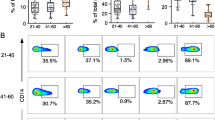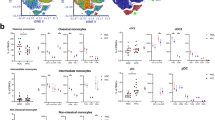Abstract
The expression of monocyte cell-surface receptors represents one index of immune dysfunction, which is common with aging. Although mouse models of aging are prevalent, monocyte subset assessment is rare. Our purpose was to compare cell receptor expression on classic (CD115+/Gr-1high) and non-classic (CD115+/Gr-1low) monocytes from 80- or 20-week-old CD-1 mice. Three-colour flow cytometry was used to determine the concentration of monocyte subsets and their respective cell-surface expression of TLR2, TLR4, CD80, CD86, MHC II and CD54. These receptors were selected because they have been previously associated with altered monocyte function. Data were analysed with independent t-tests; significance was set at P < 0.05. Old mice had a greater concentration of both classic (258%, P = 0.003) and non-classic (70%, P = 0.026) monocytes. The classic : non-classic monocyte ratio doubled in old as compared with that in young mice (P = 0.006), indicating a pro-inflammatory shift. TLR4 (↓27%, P = 0.001) and CD80 (↓37%, P = 0.004) were decreased on classic monocytes from old as compared with those from young mice. TLR2 (↑24%, P = 0.002) and MHCII (↓21%, P = 0.026) were altered on non-classic monocytes from old as compared with those from young mice. The increased classic : non-classic monocyte ratio combined with changes in the cell-surface receptor expression on both monocyte subsets is indicative of immune dysfunction, which may increase age-associated disease risk.



Similar content being viewed by others
References
Afiune Neto A, Mansur AP, Avakian SD, Gomes EP and Ramires JA 2006 Monocytosis is an independent risk marker for coronary artery disease Arq. Bras. Cardiol. 86 240–244
Boehmer ED, Goral J, Faunce DE and Kovacs EJ 2004 Age-dependent decrease in Toll-like receptor 4-mediated proinflammatory cytokine production and mitogen-activated protein kinase expression. J. Leukoc. Biol. 75 342–349
Boucher N, Dufeu-Duchesne T, Vicaut E, Farge D, Effros RB and Schächter F 1998 CD28 expression in T cell aging and human longevity. Exp. Gerontol. 33 267–282
Breslin WL, Strohacker K, Carpenter KC, Haviland DL, McFarlin BK 2011 Mouse blood monocytes: standardizing their identification and analysis using CD115. J. Immunol. Methods. doi: 10.1016/j.jim.2011.03.005
Cesari M, Penninx BW, Newman AB, Kritchevsky SB, Nicklas BJ, Sutton-Tyrrell K, Tracy RP, Rubin SM, Harris TB and Pahor M 2003 Inflammatory markers and cardiovascular disease (The Health, Aging and Body Composition [Health ABC] Study). Am. J. Cardiol. 92 522–528
Curat CA, Miranville A, Sengenès C, Diehl M, Tonus C, Busse R and Bouloumié A 2004 From blood monocytes to adipose tissue-resident macrophages: induction of diapedesis by human mature adipocytes. Diabetes 53 1285–1292
Daley JM, Thomay AA, Connolly MD, Reichner JS and Albina JE 2008 Use of Ly6G-specific monoclonal antibody to deplete neutrophils in mice. J. Leukoc. Biol. 83 64–70
de Waal Malefyt R, Haanen J, Spits H, Roncarolo MG, te Velde A, Figdor C, Johnson K, Kastelein R, Yssel H and de Vries JE 1991 Interleukin 10 (IL-10) and viral IL-10 strongly reduce antigen-specific human T cell proliferation by diminishing the antigen-presenting capacity of monocytes via downregulation of class II major histocompatibility complex expression. J. Exp. Med. 174 915–924
Ernst DN, Weigle WO, Noonan DJ, McQuitty DN and Hobbs MV 1993 The age-associated increase in IFN-gamma synthesis by mouse CD8+ T cells correlates with shifts in the frequencies of cell subsets defined by membrane CD44, CD45RB, 3G11, and MEL-14 expression. J. Immunol. 151 575–587
Esch T and Stefano G 2002 Proinflammation: a common denominator or initiator of different pathophysiological disease processes. Med. Sci. Monit. 8 HY1-9
Esposito LM, Simpson RJ, Strohacker K, Carpenter KC and McFarlin BK 2010 Defining a longitudinal survival model to examine forced treadmill running as a countermeasure for diet-induced weight gain. Lab. Anim. 44 305–311
Fleischer J, Soeth E, Reiling N, Grage-Griebenow E, Flad HD and Ernst M 1996 Differential expression and function of CD80 (B7-1) and CD86 (B7-2) on human peripheral blood monocytes. Immunology 89 592–598
Frankenberger M, Sternsdorf T, Pechumer H, Pforte A and Ziegler-Heitbrock HW 1996 Differential cytokine expression in human blood monocyte subpopulations: a polymerase chain reaction analysis. Blood 87 373–377
Gordon S and Taylor PR 2005 Monocyte and macrophage heterogeneity. Nat. Rev. Immunol. 5 953–964
Licastro F, Candore G, Lio D, Porcellini E, Colonna-Romano G, Franceschi C and Caruso C 2005 Innate immunity and inflammation in ageing: a key for understanding age-related diseases. Immun. Ageing 2 8
Matsuguchi T, Musikacharoen T, Ogawa T and Yoshikai Y 2000 Gene expressions of Toll-like receptor 2, but not Toll-like receptor 4, is induced by LPS and inflammatory cytokines in mouse macrophages. J. Immunol. 165 5767–5772
McFarlin BK, Flynn MG, Campbell WW, Craig BA, Robinson JP, Stewart LK, Timmerman KL and Coen PM 2006 Physical activity status, but not age, influences inflammatory biomarkers and toll-like receptor 4. J. Gerontol. A Biol. Sci. Med. Sci. 61 388–393
McFarlin BK, Flynn MG, Campbell WW, Stewart LK and Timmerman KL 2004 TLR4 is lower in resistance-trained older women and related to inflammatory cytokines. Med. Sci. Sports Exerc. 36 1876–1883
Renshaw M, Rockwell J, Engleman C, Gewirtz A, Katz J and Sambhara S 2002 Cutting edge: impaired Toll-like receptor expression and function in aging. J. Immunol. 169 4697–4701
Sadeghi HM, Schnelle JF, Thomas JK, Nishanian P and Fahey JL 1999 Phenotypic and functional characteristics of circulating monocytes of elderly persons. Exp. Gerontol. 34 959–970
Saurwein-Teissl M, Blasko I, Zisterer K, Neuman B, Lang B and Grubeck-Loebenstein B 2000 An imbalance between pro- and anti-inflammatory cytokines, a characteristic feature of old age. Cytokine 12 1160–1161
Stewart LK, Flynn MG, Campbell WW, Craig BA, Robinson JP, McFarlin BK, Timmerman KL, Coen PM, Felker J and Talbert E 2005 Influence of exercise training and age on CD14+ cell-surface expression of toll-like receptor 2 and 4. Brain Behav. Immun. 19 389–397
Sunderkötter C, Nikolic T, Dillon MJ, van Rooijen N, Stehling M, Drevets DA and Leenen PJM 2004 Subpopulations of mouse blood monocytes differ in maturation stage and inflammatory response. J. Immunol. 172 4410–4417
Swirski FK, Libby P, Aikawa E, Alcaide P, Luscinskas FW, Weissleder R and Pittet MJ 2007 Ly-6Chi monocytes dominate hypercholesterolemia-associated monocytosis and give rise to macrophages in atheromata. J. Clin. Invest. 117 195–205
Tacke F, Alvarez D, Kaplan TJ, Jakubzick C, Spanbroek R, Llodra J, Garin A, Liu J, et al. 2007 Monocyte subsets differentially employ CCR2, CCR5, and CX3CR1 to accumulate within atherosclerotic plaques. J. Clin. Invest. 117 185–194
van Duin D, Allore HG, Mohanty S, Ginter S, Newman FK, Belshe RB, Medzhitov R and Shaw AC 2007 Prevaccine determination of the expression of costimulatory B7 molecules in activated monocytes predicts influenza vaccine responses in young and older adults. J. Infect. Dis. 195 1590–1597
Acknowledgements
No author on this manuscript reported any conflict of interest. This project was funded in part by a student research grant (PI: Strohacker) received from the Texas Obesity Research Center (Houston, Texas).
Author information
Authors and Affiliations
Corresponding author
Additional information
Corresponding editor: Durgadas P Kasbekar
[Strohacker K, Breslin WL, Carpenter KC and McFarlin BK 2012 Aged mice have increased inflammatory monocyte concentration and altered expression of cell-surface functional receptors. J. Biosci. 37 XXX–XXX] DOI
Rights and permissions
About this article
Cite this article
Strohacker, K., Breslin, W.L., Carpenter, K.C. et al. Aged mice have increased inflammatory monocyte concentration and altered expression of cell-surface functional receptors. J Biosci 37, 55–62 (2012). https://doi.org/10.1007/s12038-011-9169-z
Received:
Accepted:
Published:
Issue Date:
DOI: https://doi.org/10.1007/s12038-011-9169-z




